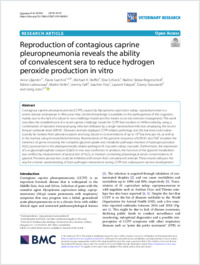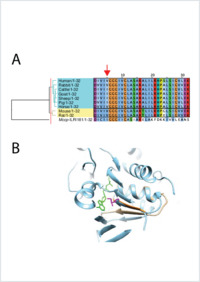Reproduction of contagious caprine pleuropneumonia reveals the ability of convalescent sera to reduce hydrogen peroxide production in vitro
- Liljander, Anne International Livestock Research Institute, Nairobi, Kenya
- Sacchini, Flavio International Livestock Research Institute, Nairobi, Kenya - Institute of Veterinary Bacteriology, Vetsuisse Faculty, University of Bern, Switzerland - Istituto Zooprofilattico Sperimentale dell’Abruzzo e del Molise “G. Caporale”, Teramo, Italy
- Stoffel, Michael H. Division of Veterinary Anatomy, Vetsuisse Faculty, University of Bern, Switzerland
- Schieck, Elise International Livestock Research Institute, Nairobi, Kenya
- Stokar‑Regenscheit, Nadine Institute of Animal Pathology (COMPATH), Vetsuisse Faculty, University of Bern, Switzerland
- Labroussaa, Fabien Institute of Veterinary Bacteriology, Vetsuisse Faculty, University of Bern, Switzerland
- Heller, Martin Friedrich-Loeffler-Institute-Federal Research Institute for Animal Health, Jena, Germany
- Salt, Jeremy GALVmed, Doherty Building, Pentlands Science Park, Edinburgh, Scotland, UK
- Frey, Joachim Institute of Veterinary Bacteriology, Vetsuisse Faculty, University of Bern, Switzerland
- Falquet, Laurent Division of Biochemistry, Department of Biology, University of Fribourg and Swiss Institute of Bioinformatics, Switzerland
- Goovaerts, Danny GALVmed, Doherty Building, Pentlands Science Park, Edinburgh, Scotland, UK
- Jores, Joerg International Livestock Research Institute, Nairobi, Kenya - Institute of Veterinary Bacteriology, Vetsuisse Faculty, University of Bern, Switzerland
-
08.02.2019
Published in:
- Veterinary Research. - 2019, vol. 50, no. 1, p. 10
English
Contagious caprine pleuropneumonia (CCPP), caused by Mycoplasma capricolum subsp. capripneumoniae is a severe disease widespread in Africa and Asia. Limited knowledge is available on the pathogenesis of this organism, mainly due to the lack of a robust in vivo challenge model and the means to do site-directed mutagenesis. This work describes the establishment of a novel caprine challenge model for CCPP that resulted in 100% morbidity using a combination of repeated intranasal spray infection followed by a single transtracheal infection employing the recent Kenyan outbreak strain ILRI181. Diseased animals displayed CCPP-related pathology and the bacteria could subsequently be isolated from pleural exudates and lung tissues in concentrations of up to 109 bacteria per mL as well as in the trachea using immunohistochemistry. Reannotation of the genome sequence of ILRI181 and F38T revealed the existence of genes encoding the complete glycerol uptake and metabolic pathways involved in hydrogen peroxide (H2O2) production in the phylogenetically related pathogen M. mycoides subsp. mycoides. Furthermore, the expression of L-α- glycerophosphate oxidase (GlpO) in vivo was confirmed. In addition, the function of the glycerol metabolism was verified by measurement of production of H2O2 in medium containing physiological serum concentrations of glycerol. Peroxide production could be inhibited with serum from convalescent animals. These results will pave the way for a better understanding of host–pathogen interactions during CCPP and subsequent vaccine development.
- Faculty
- Faculté des sciences et de médecine
- Department
- Département de Biologie
- Language
-
- English
- Classification
- Biological sciences
- License
-
License undefined
- Identifiers
-
- RERO DOC 324273
- DOI 10.1186/s13567-019-0628-0
- Persistent URL
- https://folia.unifr.ch/unifr/documents/307578
Other files
Statistics
Document views: 100
File downloads:
- pdf: 176
- Supplementary material: 113

